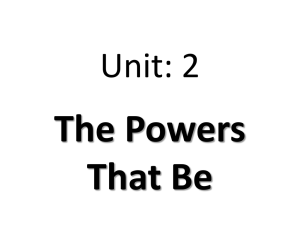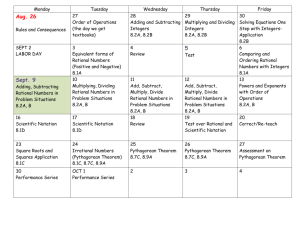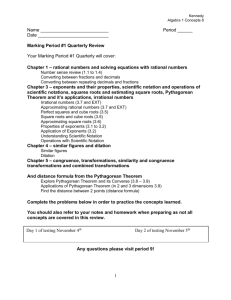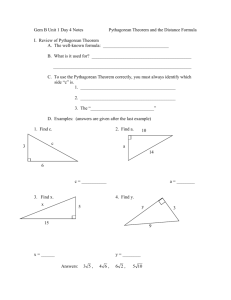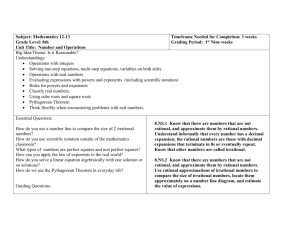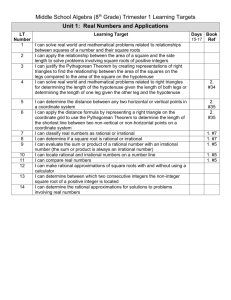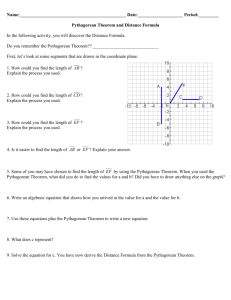Unit Overview
advertisement
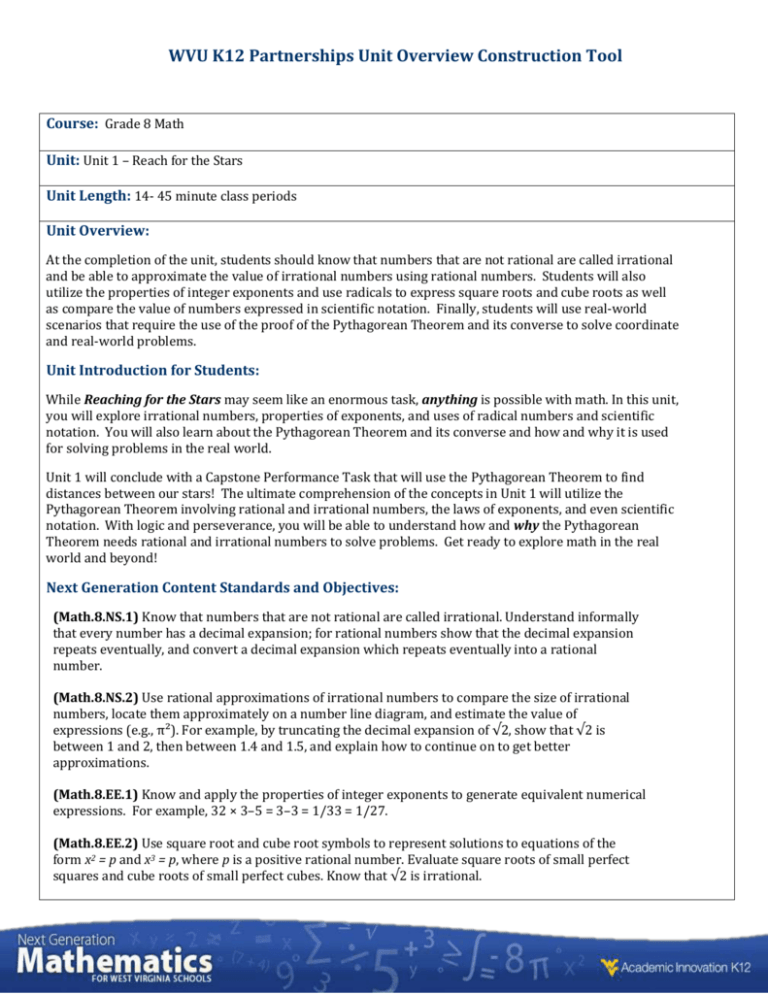
WVU K12 Partnerships Unit Overview Construction Tool Course: Grade 8 Math Unit: Unit 1 – Reach for the Stars Unit Length: 14- 45 minute class periods Unit Overview: At the completion of the unit, students should know that numbers that are not rational are called irrational and be able to approximate the value of irrational numbers using rational numbers. Students will also utilize the properties of integer exponents and use radicals to express square roots and cube roots as well as compare the value of numbers expressed in scientific notation. Finally, students will use real-world scenarios that require the use of the proof of the Pythagorean Theorem and its converse to solve coordinate and real-world problems. Unit Introduction for Students: While Reaching for the Stars may seem like an enormous task, anything is possible with math. In this unit, you will explore irrational numbers, properties of exponents, and uses of radical numbers and scientific notation. You will also learn about the Pythagorean Theorem and its converse and how and why it is used for solving problems in the real world. Unit 1 will conclude with a Capstone Performance Task that will use the Pythagorean Theorem to find distances between our stars! The ultimate comprehension of the concepts in Unit 1 will utilize the Pythagorean Theorem involving rational and irrational numbers, the laws of exponents, and even scientific notation. With logic and perseverance, you will be able to understand how and why the Pythagorean Theorem needs rational and irrational numbers to solve problems. Get ready to explore math in the real world and beyond! Next Generation Content Standards and Objectives: (Math.8.NS.1) Know that numbers that are not rational are called irrational. Understand informally that every number has a decimal expansion; for rational numbers show that the decimal expansion repeats eventually, and convert a decimal expansion which repeats eventually into a rational number. (Math.8.NS.2) Use rational approximations of irrational numbers to compare the size of irrational numbers, locate them approximately on a number line diagram, and estimate the value of expressions (e.g., π²). For example, by truncating the decimal expansion of √2, show that √2 is between 1 and 2, then between 1.4 and 1.5, and explain how to continue on to get better approximations. (Math.8.EE.1) Know and apply the properties of integer exponents to generate equivalent numerical expressions. For example, 32 × 3–5 = 3–3 = 1/33 = 1/27. (Math.8.EE.2) Use square root and cube root symbols to represent solutions to equations of the form x2 = p and x3 = p, where p is a positive rational number. Evaluate square roots of small perfect squares and cube roots of small perfect cubes. Know that √2 is irrational. WVU K12 Partnerships Unit Overview Construction Tool (Math.8.EE3) Use numbers expressed in the form of a single digit times an integer power of 10 to estimate very large or very small quantities, and to express how many times as much one is than the other. For example, estimate the population of the United States as 3 x 108 and the population of the world as 7 x 109, and determine that the world population is more than 20 times larger. (Math.8.EE.4) Perform operations with numbers expressed in scientific notation, including problems where both decimal and scientific notation are used. Use scientific notation and choose units of appropriate size for measurements of very large or very small quantities (e.g., use millimeters per year for seafloor spreading). Interpret scientific notation that has been generated by technology. (Math.8.G.6) Explain a proof of the Pythagorean Theorem and its converse. (Math.8.G.7) Apply the Pythagorean Theorem to determine unknown side lengths in right triangles in real-world and mathematical problems in two and three dimensions. (Math.8.G8) Apply the Pythagorean Theorem to find the distance between two points in a coordinate system. Standards for Mathematical Practices: 1. 2. 3. 4. 5. 6. 7. 8. Make sense of problems and persevere in solving them. Reason abstractly and quantitatively. Construct viable arguments and critique the reasoning of others. Model with mathematics. Use appropriate tools strategically. Attend to precision. Look for and make use of structure. Look for and express regularity in repeated reasoning Look for and express regularity in repeated reasoning Driving questions: Lesson1 o How can we classify a number as a rational number or an irrational number? o What are characteristics of an irrational number? o How do you approximate the value of an irrational number using rational numbers? Lesson2 o What happens to the value of a number when an exponent is increased or decreased? Lesson3 o What happens to powers when operations are applied? Lesson4 o How are square roots and cube roots used to solve expressions and equations? Lesson5 o How can we work with very large and very small numbers more easily? Lesson 6 o How can you effectively compare and work with values of very large or very small numbers? WVU K12 Partnerships Unit Overview Construction Tool Lesson7 o How can you perform addition and subtraction when numbers are written in scientific notation? Lesson 8 o How can you perform multiplication and division when numbers are written in scientific notation? Lesson9 o How is using the Pythagorean Theorem and its converse helpful in real-world situations? Lesson10 o How can you find the distance between two points on a coordinate plane? Capstone Task o How can you use the Pythagorean Theorem to learn about your surroundings? Overall Summary of Unit Questions: How can students manipulate expressions and equations with exponents, determining whether answers are rational or irrational, solve for unknowns that are raised to an integer exponent, and compare sizes of very small and large numbers with base ten exponents? What applications are there of this exponential manipulation, including real world application as well as measurements of side lengths when using the Pythagorean Theorem. By the End of the Unit, Students Will Know: There are numbers that are not rational and approximate them by rational numbers. The relationship between radicals and integer exponents. Numerical expressions of very large and very small quantities can be compared. Applications associated with the Pythagorean Theorem. Numerical expressions of very large and very small quantities can be compared. By the End of the Unit, Students Will: Classify numbers as either rational or irrational, as well as list the characteristics of irrational numbers. Approximate the values of irrational numbers on a number line. Derive laws of exponents when multiplying and dividing integer exponents. Find roots of small perfect squares and cubes. Use roots as a technique to remove exponents from a variable when solving. Find magnitude change of values expressed in scientific notation. Perform operations on numbers expressed in scientific notation. Apply scientific notational appropriately in real world application. Prove the Pythagorean Theorem and its converse and the importance of accuracy. Apply the Pythagorean Theorem to determine unknown side lengths in real-world application problems. WVU K12 Partnerships Unit Overview Construction Tool Relate the measure of a hypotenuse using the Pythagorean Theorem to distance on the coordinate axis.

